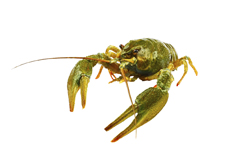Spread of invasive species in a changing climate
Increasing temperatures, sea-level rise, and changes to salinity and rainfall patterns may alter the composition of biological communities in coastal and estuarine waters. The 'Climate change and species invasions in aquatic ecosystems: A comparative perspective' (CHAOS) project addressed this problem by studying the impact of invasive species on the aquatic environment. Anthropogenic factors include aquaculture, shipping and the aquarium trade.Changes in climate leading to reduced ice cover in lakes, altered stream flows and increased salinity are expected to influence the transport of new alien species and the distribution of established alien species. Climate change can also reduce the impact of actions designed to mitigate damage, such as biological control. Rising temperatures will help warm-water species that have been introduced into temperate regions to become better established. This could result in an increase in the effects of foreign predators on indigenous prey and the virulence of alien diseases to native species. Increases in the magnitude and frequency of floods will also aid the dispersal of alien aquatic species such as zebra mussels (Dreissena polymorpha). These species cause considerable damage by blocking the water inlet pipes of power stations and other facilities. Prolonged droughts will favour the burrowing behaviour of the invasive Louisiana crayfish (Procambarus clarkii), which can outcompete native European crayfish.CHAOS researchers studied historical data on the climate of inland waters, transitional waters and coastal areas of the mid-Atlantic region of North America and Mediterranean Europe. They also examined animal species introduced into these regions together with geographical, ecological and socioeconomic variables. Laboratory experiments to determine the influence of temperature and salinity on the Chinese mitten crab (Eriocheir sinensis) were also conducted.The CHAOS project will provide a sound scientific basis for determining the links between climate change and invasive species in aquatic ecosystems. Outcomes will support the development of ecosystem management strategies and policies to help mitigate the problem.
Keywords
Climate change, invasive species, aquatic system, rising temperature, salinity, ecosystem

